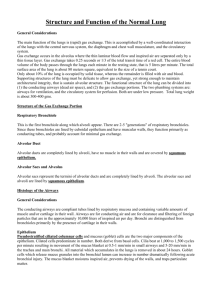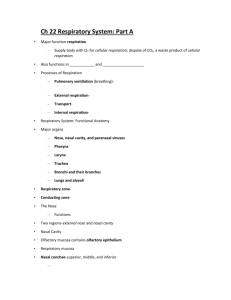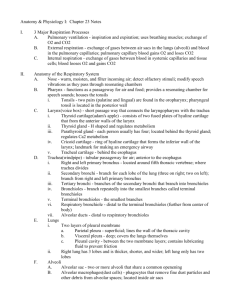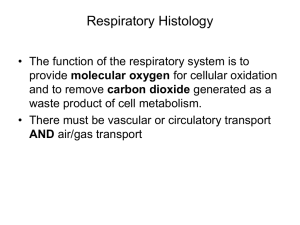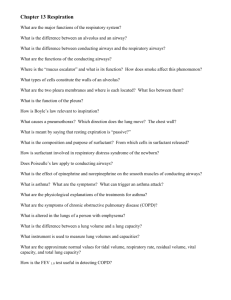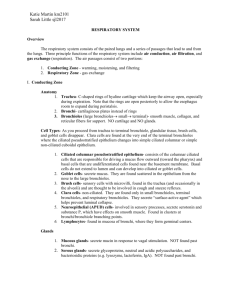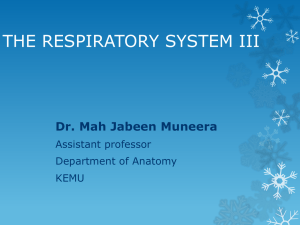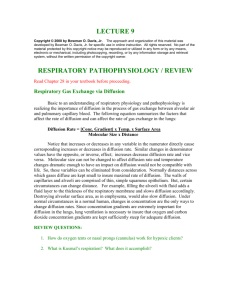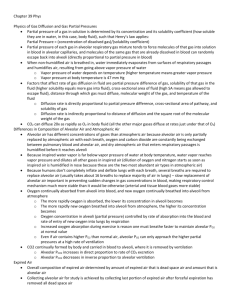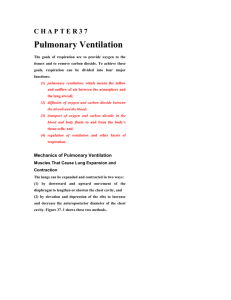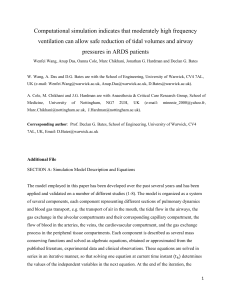Physiologically, breathing is an activity of the respiratory system
advertisement
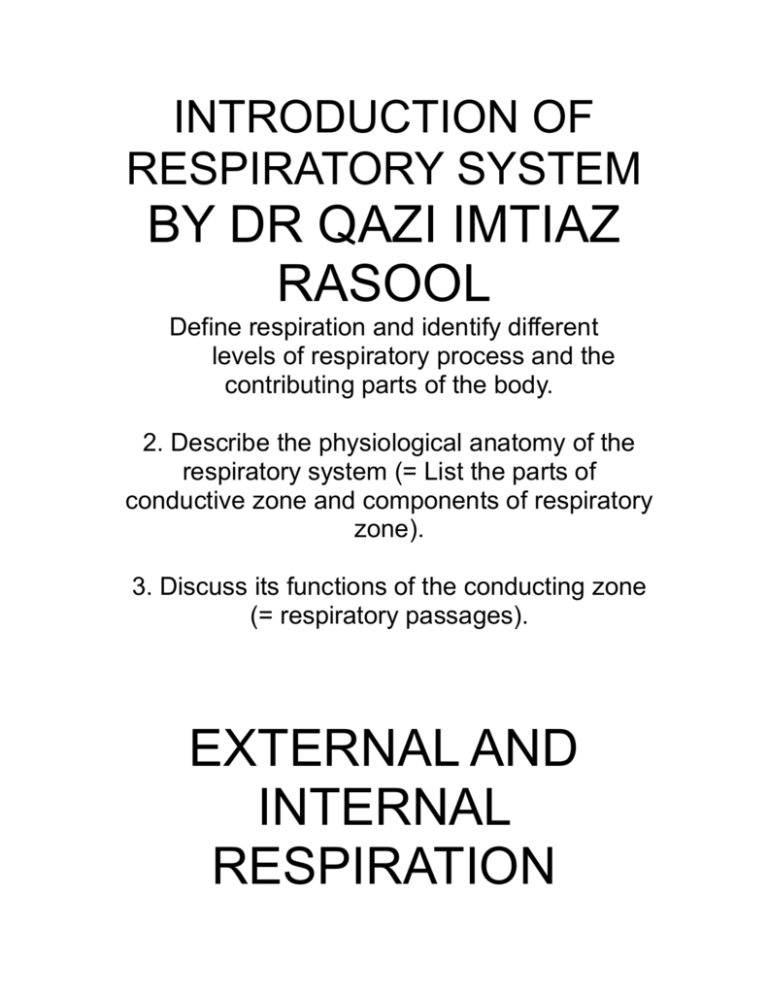
INTRODUCTION OF RESPIRATORY SYSTEM BY DR QAZI IMTIAZ RASOOL Define respiration and identify different levels of respiratory process and the contributing parts of the body. 2. Describe the physiological anatomy of the respiratory system (= List the parts of conductive zone and components of respiratory zone). 3. Discuss its functions of the conducting zone (= respiratory passages). EXTERNAL AND INTERNAL RESPIRATION Physiologically, breathing is an activity of the respiratory system Stages of the Breath: 1. Inhaling Oxygen (Air) INTO the Body: Inhalation (or inspiration) is active breathing phase. 2. Gas Exchange in the Lungs: 3. Exhaling Carbon Pharynx Larynx Lower Respiratory Tract (Tracheo-Bronchiolar tree) WEIBEL (1963) 1.Trachea R+L main bronchi 2.lobar bronchi 3.segmental bronchi 4.bronchioles 5. TERMINAL BRONCHIOLES 1.RESPIRATORY BRONCHIOLEs 2.alveolar ducts 3.atria 4. alveolar sacs conducting zone generations 1-16 respiratory zone primary lobule / or acinus generations 17-23 Generation Modifications As the generation number ↑s : 1. Airways become smaller, shorter and narrower 2. The amount of cartilage in the wall ↓s 3. The no. of submucosal glands ↓s 4. The no. of mucous-secreting cells ↓s 5. The no. of cilia ↓s 6. The total cross-sectional area 2 ↑s (2.5 cm in the 2 trachea thru 180 cm in terminal bronchioles to 2 11,800 cm in the alveoli; about are in contact with 2 capillaries7000cm ) Conducting Zone Some amount of cartilage present up to th 10 generation(prevent collapse of airways ) and absent in bronchioles Bronchioles Suspended by elastic tissue of lung parenchyma First 16 airway generations lack alveoli and form the anatomical dead space. Portion of the lung supplied by primary respiratory bronchiole is acinus Functions of Conducting zone Support and patency They distribute air evenly to deeper parts of lungs • They serve as part of Non-specific Defense System of body by removing dust, bacteria and harmful gases from resp. tract Mucociliary escalator Mucous lines the inner wall of airways like carpet & traps small foreign particles Provides a lowresistance pathway for air flow; resistance is physiologically regulated by changes in contraction of airway smooth muscle and by physical forces acting upon the airways. • Warming, humidifying and filtering of air. • Phonates (vocal cords). • Cough reflex Respiratory Zone site of gas exchange Last 7 generations of airways 17-19 generation respiratory bronchioles 20-22 generation alveolar ducts 23 alveolar sac This region is only approximately 5 mm long Alveoli start budding off from 17 gen (~ 300 million) All airways of a single terminal bronchiole (resp. bronchioles, alveolar ducts ‘n’ sacs) with associated blood and lymphatic vessels constitute a primary lobule (terminal resp. unit) Resp zone supplied by pulmonary circulation Extensive capillary network occupies 80% of alveolar surface area Perialveolar capillaries proximate blood to alveolar air— easy diffusion of gases Alveolus 75-300 µm diameter Total alveolar area in contact with capillaries in both lungs approx. 70m2 Type I-flat cells, primary lining cells of alveoli, covering 95% alveolar epithelial surface area Type II (granular pneumocytes)— → thicker, contain numerous lamellar inclusion bodies → secrete surfactant → imp. in alveolar repair → make up 5% surface area → represent 60% epithelial cells in alveoli Other cells of alveolus Pulmonary alveolar macrophages Lymphocytes Plasma cells Mast cells containing APUD cells heparin, histamine, lipids & proteases that participate in allergic Respiratory membrane (airblood barrier) or (Alveolarcapillary membrane) is composed of: Primary function is gas exchange Functions of respiratory bronchioles and alveoli 1.External respiration 2. Defence against microbes 1.lymphocytes 2. plasma cells, 3. macrophages 3. Warming and humidifying II. Non-respiratory functions a) Left ventricular reservoir= 0.5 L of blood b) Filtering small emboli = Clots, fat or air bubbles: c) Biochemical functions= → chemical substances removed PGE2, PGF2a, leukotriens, serotonin and bradykinin; → 250 volatile substances removed i.e methane(from intestines), alcohol, acetone, etc. d) Olfactory function e) Coughing and sneezing f) Processing of inhaled air –filtration of toxic substances & organisms g) Endocrine function—converts ANG1 to ANG2 h) Defense functions=→ alveolar & interstitial macrophages remove particles < 2µm → IgA, collectins (including Surfactant A and D), → defensins and proteases, reactive oxygen PGE2 → chemokines and cytokines secrete (immune cells) i) Metabolic functions— synthesis of surfactant lyse clot (local fibrinolytic system) synthesis of local hormones like histamine, kallikrein, PGs j) Temperature control=panting INTERESTING FACTS Lungs are in a space with a volume of approximately 4 L, and surface area for gas exchange is the size of a tennis court (∼70-85 2 m ). Adults, the lung weighs = 1 kg, with lung tissue accounting for 60% Volume of the nose in an adult is 20 mL Lymphatic channels are more abundant in the lungs than in any other organ Circulation to the lung is unique in its dual circulation and ability to accommodate large volumes of blood at low pressure.
